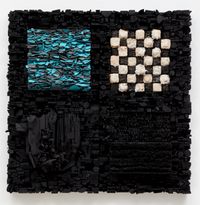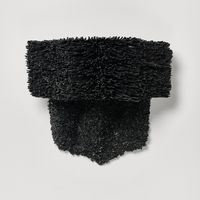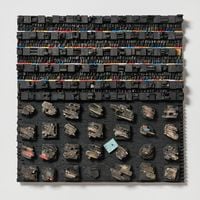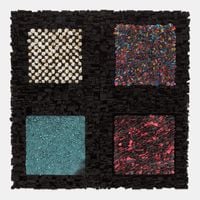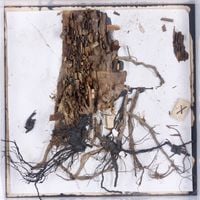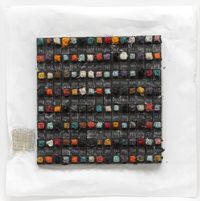Artist Leonardo Drew is known for his large-scale sculptures which address personal experiences and the cyclical nature of life and death through charged materials.
Read MoreDrew was born in 1961 in Tallahassee, Florida. He spent his childhood in Bridgeport, Connecticut, where the windows of his apartment overlooked the city's heaps of trash and dump. Drew's work was first publicly exhibited at the age of 13, and two years later he was being scouted by DC Comics and Marvel as an illustrator.
Drew studied at the Parsons School of Design in New York in 1981 and 1982. He received his BFA from The Cooper Union for the Advancement of Science and Art, New York in 1985.
Drew was largely inspired by the work of Jackson Pollock. Drew's large scale and enigmatic sculptures are often installed onto the wall, rather than as freestanding objects. The materials he uses in his sculptures speak towards personal experiences as a Black man who grew up in the projects, as well as reflecting on themes such as decay and death.
His seminal work Number 8 (1988), which Drew refers to as 'the mother' of his subsequent works, was made of blackened pieces of wood, rope, feathers, animal hide and bones. By weaving in this material, Drew created an ominous work that reflected chaos and deterioration as pulled from the streets.
Drew has also utilised oxidised metals in his work. Rust has become an important tool and visual language for the artist in reflecting on the history of materials. In Number 24 (1992), the artist combines rusting metal with cotton, referencing the pained history of African slavery and injustice.
Number 9C (2015), a vast wooden sculpture Drew showed at Pearl Lam Galleries in Hong Kong in 2015, is the product of 'artistic cannibalism,' whereby Drew has taken elements of old works and combined them, giving the piece what Drew feels is a 'bigger history.' An approach that Katie Fallen, writing for Ocula Magazine in 2015 described as aligning Drew's practice with 'regeneration and the cyclical nature of things'. Using decaying materials and altered found objects, these sculptures illustrate the relationship between life, death and chaos, as easily encountered in our own lived experiences.
Drew's artistic process is inherently very physical. He works for up to 20 hours a day to saw, burn and nail elements of his sculptures together. Through this process, the artist refuses to define the work he creates, noting that his construction is something that comes out of his internal spirit, and something he needs to 'get out' or externalise.
While Drew's work appears to consist of purely found materials, he has revealed that many of its elements are instead altered by him during the artistic process. In a conversation with Interview magazine Drew said, 'A lot of my things, they appear found, but I create them in the studio. The black washes, they look burnt, but that's a wash, it's layered.'
In 2019, Drew was commissioned to create a sculpture for Madison Square Park in New York. His work, the 100-foot-long City in the Grass, features a topographical view of an abstracted cityscape. Drew worked with a variety of objects such as rust and a torn carpet to create, through assemblage, an undulating sculpture revealing of a changing city.
In the same year, he was commissioned to create an installation spanning three walls of the San Francisco International Airport. Number 69S (2019) is composed of small sculptural components culled from Drew's past artworks; recycling materials and creating new meanings through the backdrop of a bustling airport full of people from different walks of life.
Arianna Mercado | Ocula | 2022
